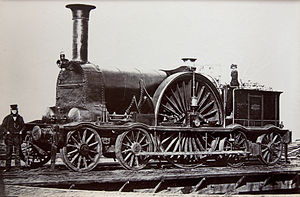 | |||||||||||||||
 Pearson 4-2-4T no. 44 of the Bristol and Exeter Railway, c. 1854 | |||||||||||||||
| |||||||||||||||
| |||||||||||||||
Under the Whyte notation for the classification of steam locomotives, 4-2-4 represents the wheel arrangement of four leading wheels on two axles, two powered driving wheels on one axle, and four trailing wheels on two axles.
The configuration was only used for tank engines, which is noted by adding letter suffixes to the configuration, such as 4-2-4T for a conventional side-tank locomotive, 4-2-4ST for a saddle-tank locomotive, 4-2-4WT for a well-tank locomotive and 4-2-4RT for a rack-equipped tank locomotive.